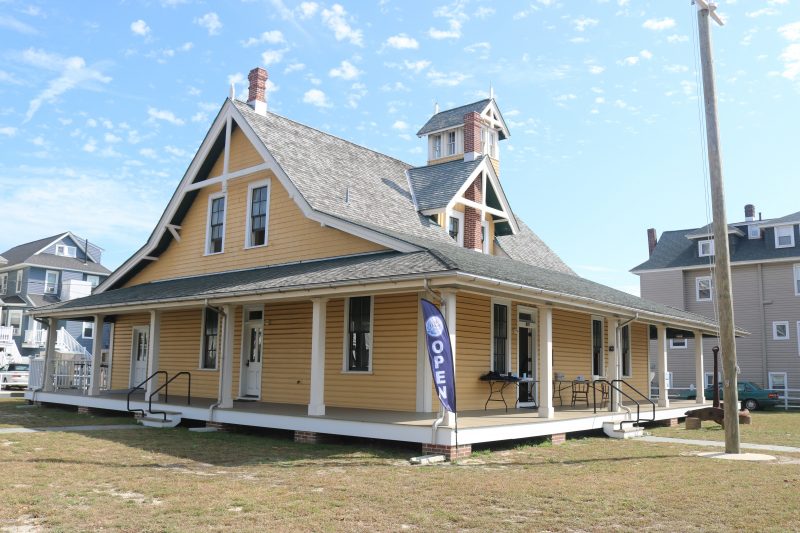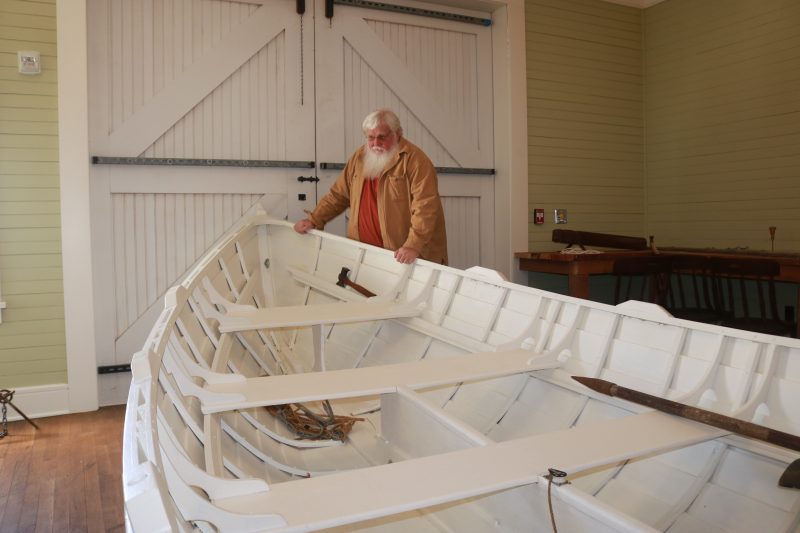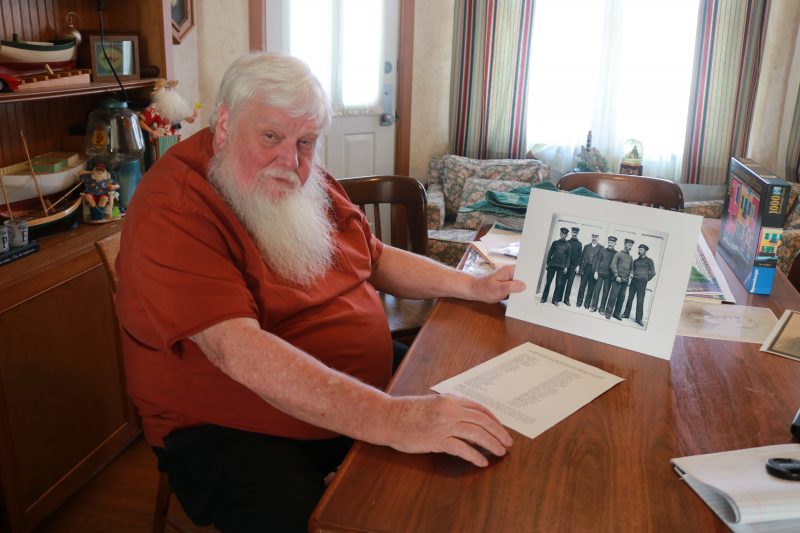Research leads to the grave sites of the brave men who rowed out to rescue people from shipwrecks off Ocean City in the late 1800s and early part of the 20th century.
 By TIM KELLY
They were strong. They were brave. Today, they are mostly unknown.
That last part is about to change, due largely to efforts here in Ocean City.
They were “surfmen,” federal employees and servicemen of the U.S. Life-Saving Service, who were forerunners to members of today’s United States Coast Guard.
Their mission: to save lives from the thousands of shipwrecks which occurred up and down the Eastern Seaboard, including many off the beaches of Ocean City, when seafaring cargo transport was the way of the world.
The stretch of ocean off South Jersey, including Ocean City, which led into the harbors of New York City, was especially dangerous.
Inadequate lighthouses, bad mapping and sometimes terrible conditions were the reasons, historians said.
Lost cargo was one thing. Lost lives were quite another. The surfmen and their now-antiquated equipment were all that stood between the shipwreck victims and a watery grave.
“Pick the worst day you’ve ever seen at the Jersey Shore, and that was a workday,” said Ocean City historian and surfmen expert John Loeper, who was recently elected president of the U.S. Life-Saving Heritage Association.
Who were they, these surfmen? They were local residents who served their city and country. Their names included familiar ones, such as Mackie Corson, as well as men famous only to their family and friends.
Their tools were teamwork and rudimentary equipment available at the time, namely wooden lifeboats and oars.
Whether famous or not, the surfmen’s common thread was dedication to their service and willingness to put their lives on the line to save others.
“They charged in there with seven men in a boat and they punched through 10-foot waves using oars and courage,” Loeper said. “They pulled the victims out and rowed them back to safety.”
By TIM KELLY
They were strong. They were brave. Today, they are mostly unknown.
That last part is about to change, due largely to efforts here in Ocean City.
They were “surfmen,” federal employees and servicemen of the U.S. Life-Saving Service, who were forerunners to members of today’s United States Coast Guard.
Their mission: to save lives from the thousands of shipwrecks which occurred up and down the Eastern Seaboard, including many off the beaches of Ocean City, when seafaring cargo transport was the way of the world.
The stretch of ocean off South Jersey, including Ocean City, which led into the harbors of New York City, was especially dangerous.
Inadequate lighthouses, bad mapping and sometimes terrible conditions were the reasons, historians said.
Lost cargo was one thing. Lost lives were quite another. The surfmen and their now-antiquated equipment were all that stood between the shipwreck victims and a watery grave.
“Pick the worst day you’ve ever seen at the Jersey Shore, and that was a workday,” said Ocean City historian and surfmen expert John Loeper, who was recently elected president of the U.S. Life-Saving Heritage Association.
Who were they, these surfmen? They were local residents who served their city and country. Their names included familiar ones, such as Mackie Corson, as well as men famous only to their family and friends.
Their tools were teamwork and rudimentary equipment available at the time, namely wooden lifeboats and oars.
Whether famous or not, the surfmen’s common thread was dedication to their service and willingness to put their lives on the line to save others.
“They charged in there with seven men in a boat and they punched through 10-foot waves using oars and courage,” Loeper said. “They pulled the victims out and rowed them back to safety.”
 Three of the early 19th century surfmen are pictured next to some vintage life-saving equipment.
Loeper said "surfmen were respected members of the community who walked tall and proud."
"They prevented shipwrecks from becoming catastrophic disasters. They were the heroes of the day,” Loeper remarked. “When they weren’t out on a rescue, they were constantly training for the next one.”
He said each man had a specific function and they “cross-trained” to learn each one.
“On a rescue, they never knew which guys would be available at a given time,” said Loeper. “They each were assigned a number.”
For example, if ‘Joe’ didn’t know ‘Mike’ or his name, then Joe simply called out to Mike by his number, Loeper explained.
In Ocean City, their headquarters may have been U.S. Life-Saving Station 30, one of three in the city.
It is now a museum, at 801 East Fourth Street, or Fourth and Atlantic.
Construction on the building was completed in 1886. Although hundreds of the Carpenter Gothic-style stations dotted the coast at that time, Ocean City’s Station 30 is the only one of its style still standing in New Jersey and one of only four left in the United States, according to published reports.
Recently, using online research, networking and some luck, the final resting places of most of the Ocean City surfmen have been located and plans are underway to formally recognize them, Loeper said.
A few graves were found at the old section of the Methodist Cemetery in Seaview, and more were discovered at a cemetery in Woodbine.
Also, through sheer luck, two more resting places were found on the grounds of a former family farmstead -- private land.
When the names of the deceased were found, photos and personal stories soon followed. Through the use of websites, such as Ancestry.com
Three of the early 19th century surfmen are pictured next to some vintage life-saving equipment.
Loeper said "surfmen were respected members of the community who walked tall and proud."
"They prevented shipwrecks from becoming catastrophic disasters. They were the heroes of the day,” Loeper remarked. “When they weren’t out on a rescue, they were constantly training for the next one.”
He said each man had a specific function and they “cross-trained” to learn each one.
“On a rescue, they never knew which guys would be available at a given time,” said Loeper. “They each were assigned a number.”
For example, if ‘Joe’ didn’t know ‘Mike’ or his name, then Joe simply called out to Mike by his number, Loeper explained.
In Ocean City, their headquarters may have been U.S. Life-Saving Station 30, one of three in the city.
It is now a museum, at 801 East Fourth Street, or Fourth and Atlantic.
Construction on the building was completed in 1886. Although hundreds of the Carpenter Gothic-style stations dotted the coast at that time, Ocean City’s Station 30 is the only one of its style still standing in New Jersey and one of only four left in the United States, according to published reports.
Recently, using online research, networking and some luck, the final resting places of most of the Ocean City surfmen have been located and plans are underway to formally recognize them, Loeper said.
A few graves were found at the old section of the Methodist Cemetery in Seaview, and more were discovered at a cemetery in Woodbine.
Also, through sheer luck, two more resting places were found on the grounds of a former family farmstead -- private land.
When the names of the deceased were found, photos and personal stories soon followed. Through the use of websites, such as Ancestry.com John Loeper stands next to a replica of a vintage lifeboat in the Ocean City Life-Saving Station.
The long-range plan is to make the names and resting places public, in order for grave decorations and other tributes to be given, as is the case with other branches of the services. The surfmen are deserving of such recognition, Loeper said.
“They found themselves in some horrendous situations,” he noted.
Loeper said some did it because they had survived their own difficult moments on the water, and felt they had to recognize it and give back. Others did it, he said, for the money.
Census figures of the time indicated a dirt farmer might have a net worth of $50, while a surfman could have a net worth between $400 and $500, Loeper pointed out.
Also, Loeper said, it was a steady paycheck a member of the surfmen could depend on, while the dirt farmer’s existence was eked out day to day.
Internet searches find glowing accounts of the surfmen’s exploits in old articles in national publications, such as Harper’s Weekly.
However, when moving freight over the sea gave way to railroads and interstate roadways, the Life-Saving Service became the Coast Guard. The surfmen mostly slipped onto the forgotten pages of the history books.
The men worked and at times lived in Life-Saving Station 30 with each other, and often with survivors who needed shelter until their relatives could be located.
It sometimes took weeks for their families to arrive at the station, which in the early days was in the middle of nowhere.
“The station was one of the first structures in the city,” Loeper said.
While waiting for the rescued folks to leave, everyone still had to eat and sleep.
Hunting and fishing and cooking on a wood-fired stove and sleeping in close quarters was routine. Whatever fish could be caught and whatever small game could be trapped or shot was on the menu.
John Loeper stands next to a replica of a vintage lifeboat in the Ocean City Life-Saving Station.
The long-range plan is to make the names and resting places public, in order for grave decorations and other tributes to be given, as is the case with other branches of the services. The surfmen are deserving of such recognition, Loeper said.
“They found themselves in some horrendous situations,” he noted.
Loeper said some did it because they had survived their own difficult moments on the water, and felt they had to recognize it and give back. Others did it, he said, for the money.
Census figures of the time indicated a dirt farmer might have a net worth of $50, while a surfman could have a net worth between $400 and $500, Loeper pointed out.
Also, Loeper said, it was a steady paycheck a member of the surfmen could depend on, while the dirt farmer’s existence was eked out day to day.
Internet searches find glowing accounts of the surfmen’s exploits in old articles in national publications, such as Harper’s Weekly.
However, when moving freight over the sea gave way to railroads and interstate roadways, the Life-Saving Service became the Coast Guard. The surfmen mostly slipped onto the forgotten pages of the history books.
The men worked and at times lived in Life-Saving Station 30 with each other, and often with survivors who needed shelter until their relatives could be located.
It sometimes took weeks for their families to arrive at the station, which in the early days was in the middle of nowhere.
“The station was one of the first structures in the city,” Loeper said.
While waiting for the rescued folks to leave, everyone still had to eat and sleep.
Hunting and fishing and cooking on a wood-fired stove and sleeping in close quarters was routine. Whatever fish could be caught and whatever small game could be trapped or shot was on the menu.
 John Loeper displays an old photo of the Ocean City surfmen who responded to the famous Sindia shipwreck in 1901.
The upside was that the building was a center of Ocean City life, Loeper said.
“The town grew around the station and they were right in the middle of it all,” he said.
Originally built close to the shoreline, shifting sands and storms deposited more beach in front of the building.
Today, it is about a quarter mile from the ocean with blocks of homes built in between. Many folks assume it is a restored facility of the Beach Patrol and don’t know it is an historic facility of the Coast Guard.
When current men and women of the Coast Guard learn of the life-saving service’s history, many are amazed.
In a posting on the Station 30 Facebook page, one Coast Guard member said, “I will never complain about our facilities again after seeing what these guys went through.”
COVID-19 has gotten in the way of the museum giving the building an identity. Regular hours and events have been sporadic since the pandemic’s outbreak.
Also, a decision was made early on in the restoration to make the station a place of “living history” rather than a traditional museum filled with exhibits.
It is set up to replicate, as closely as possible, what the station was like during its heyday into the 1920s.
It displays a fully equipped and restored surf boat, very close to an exact duplicate of those used in rescues, including that of Ocean City’s most famous shipwreck, the Sindia, which ran aground 120 years ago this month. The surfmen managed to rescue everyone aboard the Sindia.
“We have the names of all the men involved in the operation and all of the equipment used in the rescue,” Loeper said in a previously published report.
John Loeper displays an old photo of the Ocean City surfmen who responded to the famous Sindia shipwreck in 1901.
The upside was that the building was a center of Ocean City life, Loeper said.
“The town grew around the station and they were right in the middle of it all,” he said.
Originally built close to the shoreline, shifting sands and storms deposited more beach in front of the building.
Today, it is about a quarter mile from the ocean with blocks of homes built in between. Many folks assume it is a restored facility of the Beach Patrol and don’t know it is an historic facility of the Coast Guard.
When current men and women of the Coast Guard learn of the life-saving service’s history, many are amazed.
In a posting on the Station 30 Facebook page, one Coast Guard member said, “I will never complain about our facilities again after seeing what these guys went through.”
COVID-19 has gotten in the way of the museum giving the building an identity. Regular hours and events have been sporadic since the pandemic’s outbreak.
Also, a decision was made early on in the restoration to make the station a place of “living history” rather than a traditional museum filled with exhibits.
It is set up to replicate, as closely as possible, what the station was like during its heyday into the 1920s.
It displays a fully equipped and restored surf boat, very close to an exact duplicate of those used in rescues, including that of Ocean City’s most famous shipwreck, the Sindia, which ran aground 120 years ago this month. The surfmen managed to rescue everyone aboard the Sindia.
“We have the names of all the men involved in the operation and all of the equipment used in the rescue,” Loeper said in a previously published report.
 This library box is a reproduction of the ones used to transfer books from Life-Saving Stations so that the surfmen and keeper could have something to read.
Life-Saving Station 30 also includes a restored keeper’s quarters, the home to the head man at the facility. He oversaw the men and the operations, and things were busy.
“At least 100 ships would sail through Ocean City on any given day,” Loeper said. “You could sit on the beach and watch dozens of cargo vessels pass through.”
Life-Saving Station 30 stands as a reminder of those days and remains a historic gem of Ocean City’s north end.
“The surfmen never could have imagined today’s air rescues and other modern technologies used by their (historical descendants) in the Coast Guard any more than today’s servicemen could imagine rescuing people by loading a wooden boat and pushing off from the beach,” Loeper said.
“It is overdue that we recognize the sacrifice, courage and bravery of these men,” he added.
This library box is a reproduction of the ones used to transfer books from Life-Saving Stations so that the surfmen and keeper could have something to read.
Life-Saving Station 30 also includes a restored keeper’s quarters, the home to the head man at the facility. He oversaw the men and the operations, and things were busy.
“At least 100 ships would sail through Ocean City on any given day,” Loeper said. “You could sit on the beach and watch dozens of cargo vessels pass through.”
Life-Saving Station 30 stands as a reminder of those days and remains a historic gem of Ocean City’s north end.
“The surfmen never could have imagined today’s air rescues and other modern technologies used by their (historical descendants) in the Coast Guard any more than today’s servicemen could imagine rescuing people by loading a wooden boat and pushing off from the beach,” Loeper said.
“It is overdue that we recognize the sacrifice, courage and bravery of these men,” he added.